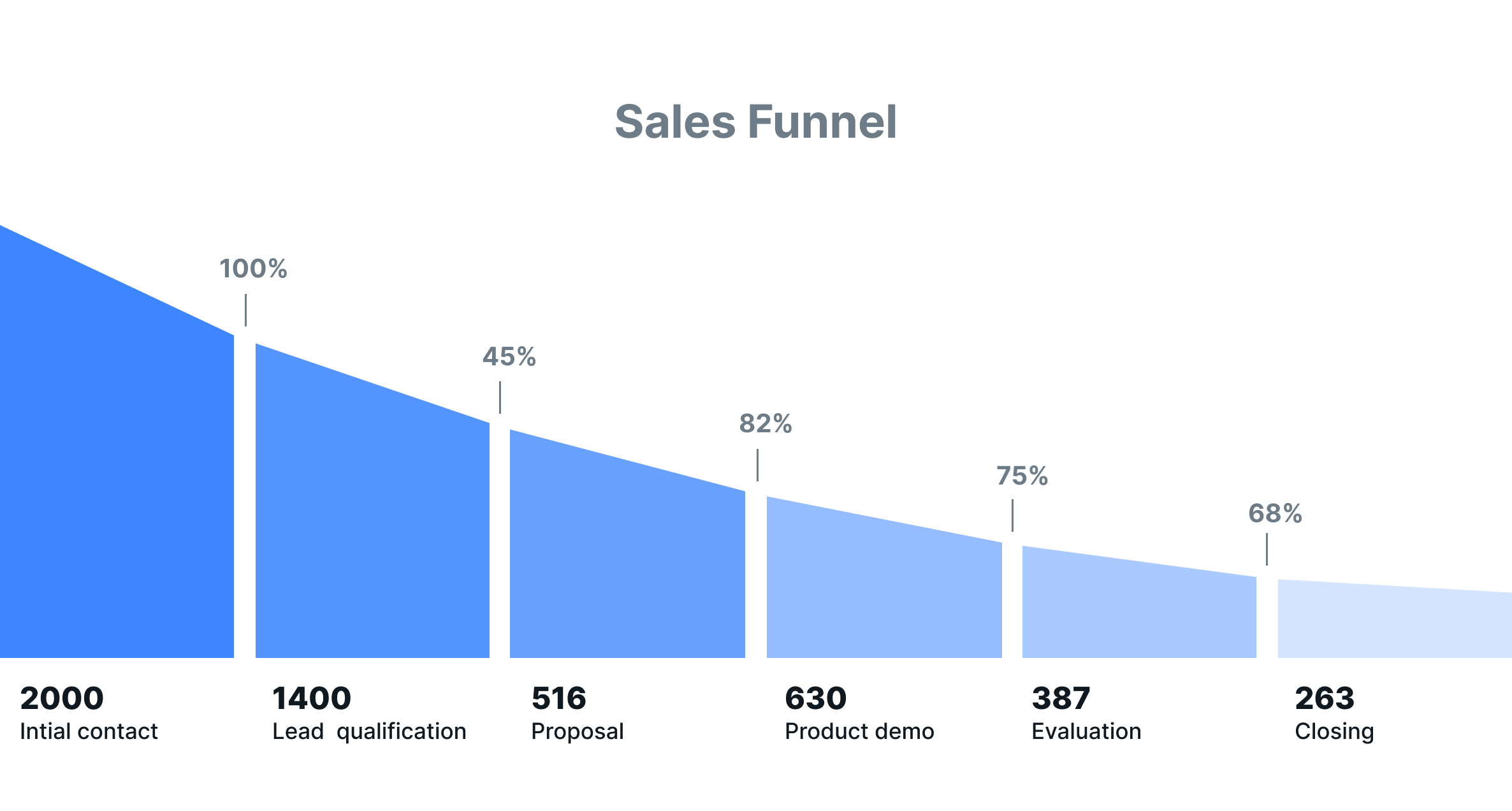
As a sales team management professional, you have a lot on your shoulders. You track your team’s performance, make sure sales reps are understanding and meeting the needs of prospects and help each rep to develop as a sales professional, all while maintaining a positive work environment.
Sales force team management is all about combining these elements to drive individual and team success. The better your results are, the better life is for everyone on your team.
Here are 10 strategies to help you reach that next level when leading your sales team.
1. Review Opportunities Throughout the Pipeline
Forecast meetings are standard elements of most sales teams’ operations. Teams and managers come together to review the data for outstanding opportunities and assess each deal’s level of potential. This is an important process for keeping your sales operations on track, but it’s not enough on its own.
Forecast meetings focus almost exclusively on deals that have progressed relatively far along the funnel. Of course, it’s important to give those nearly-there deals attention, but there’s an entire pipeline of opportunities that aren’t getting the focus they need to develop into closed sales.
Consider the following example of a sales team’s funnel:

If your team is only forecasting deals that have reached the proposal stage or beyond, three-quarters of all current opportunities aren’t on your team’s radar. You can address that disparity simply by shifting from forecast meetings to pipeline reviews, which have the same structure but which consider all of the deals in your pipeline instead.
You might conduct a pipeline review with your entire team, small subsets of the team or individual reps. Decide whether you plan to review every deal or a sampling of high-value deals, but make sure that you’re looking at opportunities at every stage. Set aside 30 minutes to an hour and go through the following steps:
- Ask a rep to summarize the deal, including its current status and what needs to happen to get to closing
- Identify roadblocks to closing
- Brainstorm action items that the rep can perform before the next meeting
- Prioritize action items based on urgency
Record what you discussed during the meeting and make notes on each team member’s level of preparation. That way, you evaluate the potential of the deal and the performance of your sales reps.
2. Formalize and Document Sales Processes
Sales teams can approach an opportunity in two possible ways.
One is to approach each buyer’s journey from scratch, deciding what to do next based on instinct: When should they follow up after a product demo? What questions should they ask to qualify the lead?
The more efficient alternative is to follow an established sales journey, taking cues from strategies that have worked in the past. That doesn’t mean using the same tactics every time—not all prospects are alike, and different people will need different approaches. But you can still provide your team with roadmaps that help them fast-track their work and move toward conversion faster.
It all starts with an examination of the buyer journey. Ask yourself where representatives typically get stuck and what works to convince leads to move forward. Look at which strategies are effective for which customer profiles.
Using all of this information, create sample buyer journeys with recommendations for each stage. These guidelines will help your team to make crucial decisions without wasting time on trial-and-error.
3. Set Goals for Individuals and Teams
Time and again, researchers have identified the benefits of goal-setting. It’s been linked to higher levels of self-confidence, motivation, and focus, as well as higher levels of achievement for both children and adults. Goals can keep your team reaching higher, but not just any goal will do the job.
The acronym you may have heard for goal-setting is “SMART.” That means setting goals that are:

These are the goals that present a challenge but are still within your reps’ reach. You’re on the right track when 80% to 90% of your people can hit their goals.
Use numbers. Make goals precise enough that people can measure their progress and know when they’ve reached their targets. And when reps are hitting their goals consistently with ease, make the numbers higher.
Set goals for individuals and teams. Consider the capabilities of each person and team—don’t set the same goals for your newest rep as your most senior. Connect goals to incentives and celebrate people when they achieve, especially when they’ve reached a new or particularly difficult goal.
4. Build Training into the Work
Comprehensive training matters. According to a study from CSO Insights, reps that receive exemplary training have higher win rates, exceed their quotas more often and meet client expectations better than reps who receive less comprehensive training.
Training needs to be thorough and it needs to be regular. The Harvard Business Review reports that after people complete a traditional training program, they forget about 80% of what they learned in less than three months. That doesn’t mean you should stop training, but it does mean you need to make it more than just a one-time thing.
Make training a routine part of your company culture. Find engaging training programs and bring them to your team, instead of asking team members to go out and find training on their own. Offer department-wide training, team training and individual self-directed sessions.
5. Be a Hands-On Coach
Sales team management isn’t just about managing—it’s about supporting your people and guiding them to success.
Coaching is a focused and guided process that helps each person reach their potential. To be an effective coach, you need to build a relationship with your reps. You need to sit down with them and offer yourself as a helpful resource whose goal is to guide, suggest and motivate.
Formalize your relationship as a coach to your reps. With each team member, sit down to set a short-term and long-term vision for success. Then establish expectations for how often you’re going to check in about progress.

Make it clear that the rep is just as much in control over the process as you are. When they’re more motivated to develop their skills, they’ll be more motivated to apply them.
6. Give Specific Feedback Regularly
There’s a common misconception that constructive feedback can be scary or discouraging. The numbers tell a different story:
- More than 75% of surveyed employees value feedback
- Nearly 60% of employees and 72% of employees under 30 want feedback daily or weekly
- About 92% of employees feel that constructive feedback leads to improved performance
If you’re giving feedback primarily in the context of an annual review, it’s time to change. Approximately 77% of HR executives believe that these reviews aren’t an accurate measure of performance, nor are they helpful in terms of getting results.
Instead of sitting down with an employee once a year to discuss performance, find regular opportunities to check it in. Don’t make it confrontational—tell your team that you believe in them and you’re committed to helping them do their best work. Provide suggestions for improvement, but also highlight if someone is doing particularly well.
As with goals, make your feedback specific. Use performance data to make suggestions and track improvement. When people do take feedback to heart and results improve, show them the improvement in the numbers. Invite reps to track their numbers as well.
7. Create Sales Playbooks
According to CMO Council research, sales reps spend about 40% of their time creating content. You have the power to reduce that number by creating what sales pros call “playbooks”—detailed selling plans that reps can use to approach any situation that they may face.
Unlike a process roadmap, which is geared toward an entire company or team, a playbook is geared toward the individual rep. Like a professional athlete’s playbook, it includes specific approaches and even scripts for each stage of the sales pipeline. A typical playbook might include:
- Detailed descriptions of every product or service that the rep sells
- A breakdown of each stage of the sales process
- Customer profiles for each common buyer persona that the rep handles
- A description of the sales cadence that the rep should follow
- Sample messages for each common touchpoint: positioning statements, call scripts, presentation plans, etc.
- Questions for discovery, qualification, product demos and contract negotiation
- Scripts and arguments for overcoming objections
- KPIs to track results
Each rep’s playbook should be geared toward their unique strengths and weaknesses, and everything in it should be relevant to the real-life situations your reps will face. In the end, it should include all the resources that a rep would need to make a sale.
8. Be Aware of the Competition
Your reps aren’t the only people that your potential customers are talking to. Chances are good that your prospect is someone else’s prospect as well, and it’s difficult to win that person over if you don’t know what they’re hearing from the “other side.”
You and your team need to know:
- The names of businesses that compete with you
- What products or services those companies provide
- What they charge, especially for products that are similar to yours
- What new ideas they’re developing
- How they attract and retain customers
- What their customers think of them
- Their brand value and culture
You can get this information from the same sources your prospects use.
- Look at the competitor’s website and compare it to your own, not in terms of “better” or “worse” but content and style.
- Read the reviews that customers have posted and check out their Better Business Bureau profile.
- Look for mentions of the company in trade publications, in the news and at conferences
- Call the company directly and ask for a brochure
Remember, you’re looking for information that a potential customer might be seeing when they’re comparison-shopping. Share this information with your team and talk about how you can position your company as the best choice.
9. Always Be Recruiting
A sales team isn’t a static entity. Statistics show that turnover for salespeople in the United States is approximately 27%, almost double the turnover rate for the labor force in general. That doesn’t mean that salespeople are flaky or unreliable, it just means that the good ones are usually available for recruiting.
Get out there and be one of the companies recruiting those sales top performers—but don’t go in blind. Much as you would with a customer profile, take the time to develop a sales rep persona. What kind of person thrives on your team? What qualities and experience do they have? What makes someone a good fit for the rest of your group?
Take that knowledge and create a job description. Use specific language, both in terms of the skills you need and the opportunity you’re offering. What are some of your company’s top perks? What do you offer that other companies don’t?
Once you have your job descriptions, put it out there, but be choosy about how. Start with a recruitment form on your website and invite people to it. Use LinkedIn to find them, and if they’re really good, invite them for an interview.
One more thing: make sure that you have a well-defined hiring process and a dedicated place to store candidate information. You still have a sales team to run, and you don’t want to waste time figuring out where a candidate is in the recruitment process.
10. Adopt Process Management Technology
People spend too many of their working hours searching for information. On average, employees spend 9.3 hours every week gathering information. Knowledge workers spend even more time searching—around 2.5 hours per day.
There are several kinds of information that your people might be searching out. Maybe someone can’t find the records of a prior conversation with a prospect. Another might be emailing a colleague to get information about a proposal that’s in development.
This is all time that isn’t spent with leads, winning deals. If you can reduce the amount of time that your reps spend searching for prospect or process data, you can give them more face time and close more deals.
Sales team management software can get you there. When you have a tool like Pipefy that tracks all of your sales efforts and keeps all of your client data in one place, your team can do what you hired them to do: make sales.
The Takeaway
Every day, you show up and help your team to become the best it can be. You work with individuals and follow team-level results. You create strategies at multiple levels and make sure everyone has the tools they need to succeed—and there’s always more to do.
With these 10 tips for success, you’ll take your team to the next level, closing more deals and empowering every rep to be successful. It’s time for you and your team to reach their highest potential.










